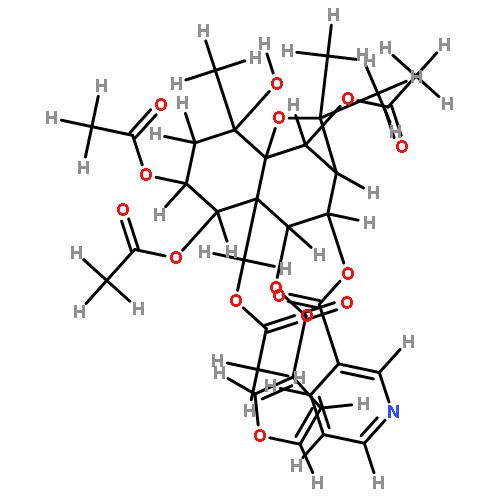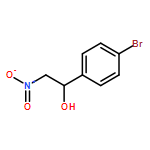Co-reporter:Aiying Guan, Mingan Wang, Jinlong Yang, Lizeng Wang, Yong Xie, Jie Lan, and Changling Liu
Journal of Agricultural and Food Chemistry December 13, 2017 Volume 65(Issue 49) pp:10829-10829
Publication Date(Web):November 18, 2017
DOI:10.1021/acs.jafc.7b03898
Downy mildew is one of the most highly destructive of the diseases that cause damage to fruits and vegetables. Because of the continual development of resistance, it is important to discover new fungicides with different modes of action from existing fungicides for the control of downy mildew. This study is a continuation of our previous work on the novel pyrimidinamine lead compound, 9, and includes field trials for the identification of the optimal candidate. A new compound, 1c, was obtained, which gave a lower EC50 value (0.10 mg/L) against downy mildew than lead compound 9 (0.19 mg/L) and the commercial fungicides diflumetorim, dimethomorph, and cyazofamid (1.01–23.06 mg/L). Compound 1c displayed similar broad-spectrum fungicidal activity to compound 9 but better field efficacy than compound 9, cyazofamid, and flumorph. The present work indicates that pyrimidinamine compound 1c is a candidate for further development as a commercial fungicide for the control of downy mildew.Keywords: development of resistance; downy mildew; pyrimidinamine fungicide candidate; unique mode of action;
Co-reporter:Aiying Guan, Mingan Wang, Wei Chen, Fan Yang, Jinlong Yang, Yu Zhao, Zhinian Li, Changling Liu
Journal of Fluorine Chemistry 2017 Volume 201(Volume 201) pp:
Publication Date(Web):1 September 2017
DOI:10.1016/j.jfluchem.2017.08.008
•Starting from ethyl 4,4-difluoro-3-oxobutanoate that is common raw material in some newly launched important SDHI fungicides.•Novel structures and the application of the intermediate derivatization methods.•Characterization of target compounds using 1H NMR, 13C NMR, 19F NMR, IR, elemental analyses and HRMS.•Excellent fungicidal activity against southern corn rust.•Detailed structure and activity relationship of target compounds.Rusts are one of the most important fungal diseases, the known target sites have already developed serious resistance to the main existing classifications of fungicides. In order to discover novel fungicides with a promising activity on rusts, twenty new substituted difluoromethylpyrimidinamine derivatives were designed and synthesized with the aid of the intermediate derivatization methods starting from ethyl 4,4-difluoro-3-oxobutanoate that is the common raw material in some newly launched important succinate dehydrogenase inhibitor (SDHI) fungicides. Their structures were identified by 1H NMR, 13C NMR, 19F NMR, IR, elemental analyses and HRMS. All the compounds were screened for in vivo fungicidal activity against southern corn rust (SCR). The preliminary bioassay results indicated that 5-chloro-6-(difluoromethyl)-N-(2-(6-(3-(trifluoromethyl)phenoxy)pyridin-3-yl)ethyl)pyrimidin-4-amine (compound J, R1 = CHF2, Alk = CH2CH2, Rn = 3-CF3) is the optimal structure with desired fungicidal activity against SCR (EC50 = 2.16 mg/L), significantly higher than commercial fungicides diflumetorim (EC50 = 53.26 mg/L) and propiconazole (EC50 = 3.92 mg/L). The structure–activity relationship of the synthesized compounds was discussed as well. This study also demonstrated that difluoromethylpyrimidinamine derivatives can be further utilized as a promising antifungal agent to control rust. Further synthesis and structure optimization studies are currently in progress.Synopsis: Starting from ethyl 4,4-difluoro-3-oxobutanoate that is the common raw material in some newly launched important succinate dehydrogenase inhibitor (SDHI) fungicides, a novel difluoromethylpyrimidine lead structure was found by means of the intermediate derivatization methods (IDM), followed by a series of interesting modifications to afford the optimized compound with a promising fungicidal activity (EC50 = 2.16 mg/L) against southern corn rust.Download high-res image (195KB)Download full-size image
Co-reporter:Aiying GuanChangling Liu, Wei Chen, Fan Yang, Yong Xie, Jinbo Zhang, Zhinian Li, Mingan Wang
Journal of Agricultural and Food Chemistry 2017 Volume 65(Issue 6) pp:
Publication Date(Web):January 25, 2017
DOI:10.1021/acs.jafc.6b05580
The pyrimidinamine diflumetorim is an ideal template for the discovery of agrochemical lead compounds due to its unique mode of action, novel chemical structure, and lack of reported resistance. To develop a new pyrimidinamine fungicide effective against cucumber downy mildew (CDM), a series of new pyrimidinamine derivatives containing an aryloxy pyridine moiety were designed and synthesized by employing the recently reported intermediate derivatization method (IDM). The structures of all compounds were identified by 1H NMR, elemental analyses, HRMS, and X-ray diffraction. Bioassays demonstrated that some of the title compounds exhibited excellent fungicidal activities against CDM. Compound 9 gave the best activity (EC50 = 0.19 mg/L), which is significantly better than the commercial fungicides diflumetorim, flumorph, and cyazofamid. The relationship between structure and fungicidal activity of the synthesized pyrimidinamines was explored. The study showed that compound 9 is a promising fungicide candidate for further development.Keywords: cucumber downy mildew; fungicidal activities; intermediate derivatization method (IDM); structure−activity relationship;
Co-reporter:Ai-Ying Guan, Chang-Ling Liu, Xu-Feng Sun, Yong Xie, Ming-An Wang
Bioorganic & Medicinal Chemistry 2016 Volume 24(Issue 3) pp:342-353
Publication Date(Web):1 February 2016
DOI:10.1016/j.bmc.2015.09.031
Pyridine-based compounds have been playing a crucial role as agrochemicals or pesticides including fungicides, insecticides/acaricides and herbicides, etc. Since most of the agrochemicals listed in the Pesticide Manual were discovered through screening programs that relied on trial-and-error testing and new agrochemical discovery is not benefiting as much from the in silico new chemical compound identification/discovery techniques used in pharmaceutical research, it has become more important to find new methods to enhance the efficiency of discovering novel lead compounds in the agrochemical field to shorten the time of research phases in order to meet changing market requirements. In this review, we selected 18 representative known agrochemicals containing a pyridine moiety and extrapolate their discovery from the perspective of Intermediate Derivatization Methods in the hope that this approach will have greater appeal to researchers engaged in the discovery of agrochemicals and/or pharmaceuticals.
Co-reporter:Tijiang Shan ; Jin Tian ; Xiaohan Wang ; Yan Mou ; Ziling Mao ; Daowan Lai ; Jungui Dai ; Youliang Peng ; Ligang Zhou ;Mingan Wang
Journal of Natural Products 2014 Volume 77(Issue 10) pp:2151-2160
Publication Date(Web):September 19, 2014
DOI:10.1021/np400988a
Nine new spirobisnaphthalenes, palmarumycins B1–B9 (1–9), along with 13 known compounds (10–22), were isolated from cultures of the fungus Berkleasmium sp., an endophyte isolated from the medicinal plant Dioscorea zingiberensis C. H. Wright. The structures of the new compounds were elucidated by analysis of the 1D and 2D NMR and HRESIMS spectra and by comparison with known compounds. Compounds 7–9 contain an uncommon 2,3-dihydro-1H-inden-1-one unit. All isolated compounds were evaluated for their antibacterial activities against Bacillus subtilis, Staphylococcus hemolyticus, Agrobacterium tumefaciens, Pseudomonas lachrymans, Ralstonia solanacearum, and Xanthomonas vesicatoria and for their antifungal effects against the spore germination of Magnaporthe oryzae. Palmarumycin C8 (22) exhibited the best antibacterial and antifungal effects. In addition, diepoxin δ (11) and palmarumycin C8 (22) showed pronounced cytotoxic activities against five human cancer cell lines (HCT-8, Bel-7402, BGC-823, A 549, A 2780) with IC50 values of 1.28–5.83 μM.
Co-reporter:Hong-Bo Dong, Ming-Yan Yang, Xiao-Teng Zhang, Ming-An Wang
Tetrahedron: Asymmetry 2014 Volume 25(Issue 8) pp:610-616
Publication Date(Web):30 April 2014
DOI:10.1016/j.tetasy.2014.03.006
An asymmetric total synthesis of (5S,6R)-(+)-erythro-6-acetoxy-5-hexadecanolide 1a has been accomplished from readily available hex-5-yn-1-ol via Shi’s asymmetric epoxidation as the key step, in eight steps with an overall yield of 33.5%. In addition, the stereoselective synthesis of all four isomers of 6-acetoxy-5-hexadecanolide 1a–1d were obtained via Sharpless asymmetric dihydroxylation and Mitsunobu reaction as the key steps with overall yields of 16.5–21.2%, respectively.4-((2R,3R)-3-Decyloxiran-2-yl)butan-1-olC16H32O2[α]D25 = +26.7 (c 0.52, CHCl3)Source of chirality: Shi’s asymmetric epoxidation reactionAbsolute configuration: (2R,3R)(5R,6R)-6-Hydroxy-5-hexadecanolideC16H30O3[α]D25 = −10.5° (c 1.2, CHCl3)Source of chirality: Sharpless AD reactionAbsolute configuration: (5R,6R)(5S,6S)-6-Hydroxy-5-hexadecanolideC16H30O3[α]D25 = +9.8° (c 0.73, CHCl3)Source of chirality: Sharpless AD reactionAbsolute configuration: (5S,6S)(5R,6S)-6-Hydroxy-5-hexadecanolideC16H30O3[α]D25 = −12.5° (c 0.75, CHCl3)Source of chirality: Sharpless AD reactionAbsolute configuration: (5R,6S)(5S,6R)-6-Hydroxy-5-hexadecanolideC16H30O3[α]D25 = +12.0 (c 0.42, CHCl3)Source of chirality: Sharpless AD reactionAbsolute configuration: (5S,6R)(5R,6S)-6-Hydroxy-5-hexadecanolide-4-nitrobenzoateC23H33NO6ee = 97.9%[α]D25 = +10.8 (c 0.44, CHCl3)Source of chirality: Asymmetric synthesisAbsolute configuration: (5R,6S)(5S,6R)-6-Hydroxy-5-hexadecanolide-4-nitrobenzoateC23H33NO6ee = 98.7%[α]D25 = −11.2 (c 0.23, CHCl3)Source of chirality: Asymmetric synthesisAbsolute configuration: (5S,6R)(5R,6R)-6-Acetoxy-5-hexadecanolideC18H32O4[α]D25 = +14.6 (c 0.12, CHCl3)Source of chirality: Asymmetric synthesisAbsolute configuration: (5R,6R)(5S,6S)-6-Acetoxy-5-hexadecanolideC18H32O4[α]D25 = −13.7 (c 0.10, CHCl3)Source of chirality: Asymmetric synthesisAbsolute configuration: (5S,6S)(5R,6S)-6-Acetoxy-5-hexadecanolideC18H32O4[α]D25 = −37.4 (c 0.65, CHCl3)Source of chirality: Asymmetric synthesisAbsolute configuration: (5R,6S)(5S,6R)-6-Acetoxy-5-hexadecanolideC18H32O4[α]D25 = +38.0 (c 0.60, CHCl3)Source of chirality: Asymmetric synthesisAbsolute configuration: (5S,6R)


![2-chloro-3,7-dihydroxy-9-methoxy-1-methyl-6H-dibenzo[b,d]pyran-6-one](http://img.cochemist.com/ccimg/1233900/1233836-28-6.png)
![2-chloro-3,7-dihydroxy-9-methoxy-1-methyl-6H-dibenzo[b,d]pyran-6-one](http://img.cochemist.com/ccimg/1233900/1233836-28-6_b.png)

















